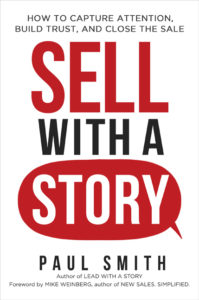Podcast (lead-with-a-story-podcast-series): Play in new window | Download | Embed
Subscribe: RSS
 When my then son Matthew came home from his first day of fifth grade, he announced, “I’m going to learn to play the euphonium!”
When my then son Matthew came home from his first day of fifth grade, he announced, “I’m going to learn to play the euphonium!”
I said, “That’s great!” Then I sheepishly added, “Uh, what’s a euphonium?”
In response, he just matter-of-factly said, “It’s like a small tuba that makes higher notes.”
All I had left to say was, “Well I can’t wait to hear you play!” I had no further questions about the instrument. Despite never having heard of a euphonium, I now knew exactly what it looked like, how it worked, how he would hold it, and how it sounded. I knew all that because I already knew what a tuba was. So it was easy to picture an instrument somewhat smaller and making higher notes.
But imagine, instead, if my son had answered my question by giving me the dictionary definition of a euphonium: “A euphonium is a musical instrument in the brass family with three valves, a conical bore, an upward-pointing bell, a cup-shaped mouthpiece projecting at a right angle, and that produces tenor tones.”
Granted, that’s a very precise and accurate description. And if I were to ask him to repeat it two or three times slowly, I could probably get a rough image in my head of what it might look like and sound like. But that image wouldn’t be nearly as accurate as the one I formed immediately after he gave me the tuba metaphor. And it would have taken a lot more time and mental energy to construct.
So, why did the metaphor provide a more accurate and efficient description? Because most of the details of what a euphonium is already existed in my mind. Details like the upward-pointing bell, the cup-shaped mouthpiece, and brass family were already there. They were just attached in my brain to the word tuba. All my son had to do was help me access them and alter them slightly (smaller with higher notes).
That’s how metaphors work. They use words or phrases that already have entire stories attached to them inside our brain.
Unfortunately, business leaders are often hesitant to use metaphors at work. Some they think it’ll make them sound unprofessional or imprecise. It won’t. But don’t take my word for it. Judge for yourself. Did you have a more accurate understanding of a euphonium after hearing the tuba metaphor or the dictionary definition? The tuba metaphor, right? Me too. It seems my son was wiser in this case than most adults.
So, in this post, I wanted to share some of my favorite metaphors used by business leaders for leadership storytelling, and share a couple of methods of finding great metaphors of your own.
The first three on my list are ones I’ve shared before. So, I’ll just put the links to them here.
1) One was a metaphor about a Yellow Taxi Cab that the CEO of Alltel used to get a venture capital firm to make a $28 billion investment.
2) The second was a metaphor about the Old West Pioneers and Settlers that Delaine Hampton used to keep her team of innovators inspired.
3) And the third one was a metaphor about a Shrinking Giant that helps people build courage for their biggest challenges at work.
But in this post, I’m going to share three more. And the first comes from the happiest place on Earth.
4) Disney’s Cast Members
At most companies, employees are referred to simply as employees. At other companies, like Walmart, they’re called associates. At Disney World, however, they’re called cast members. And that’s not just for the woman playing Cinderella, or the guy in the Goofy costume. All of the people working at Disney World are called cast members, even if they sell tickets, take pictures, or sweep the streets.
They do this because Disney isn’t really selling a product. It’s selling an experience. Every person working at the park can and does have an impact on the experience its guests have. It’s a powerful metaphor because it helps people working there to understand how to behave in just about any situation without having to be uniquely trained for each possibility.
Let’s see how that might play out. Imagine that you’re the person who serves ice cream in a soda shop at Disney World. Little Johnny comes in, and his parents buy him an ice cream cone. You give Johnny his ice cream and as he turns around to leave, he accidentally drops it, spilling his ice cream all over the floor. He bursts into tears. Quick, what do you do?
You get him another one, of course! Do you make Johnny wait in line again? No. Do you make Johnny’s parents pay for the second ice cream cone? No. Why not? Because that would ruin the experience. In fact, a bad experience is happening right now before your very eyes! And you, the ice cream dispenser, are the only person in the park who can fix it. Not Peter Pan. Not the Little Mermaid. Not even Mickey Mouse. You. You are the star of this show.
Did your boss have to tell you to get Johnny another ice cream cone? Did she have to tell you to not make Johnny wait in line, or to not charge his parents again? No. You knew what to do because you are a Disney cast member.
Now, imagine the same situation, but this time you’re an “employee” at a fast-food restaurant. Little Johnny comes in and buys an ice cream cone. He turns to leave and spills it on the floor. What do you do? You probably won’t do anything, since you’re back behind the counter where you’re supposed to be. You might think to yourself, “Gee, tough luck, kid,” as Johnny and his parents get back in line to buy another ice cream cone.
And who’s going to clean up that mess anyway? The guy in charge of cleaning up the floors, that’s who! That’s not your job. This problem is out of your hands. You’re just an employee, and your job is dispensing ice cream and collecting money. That’s it. Not cleaning floors, and certainly not managing little Johnny’s so-called experience.
The “cast member” analogy is a powerful tool Disney uses to manage customer experience. Every time it’s used, it reinforces that profound message.
Here are two more of my favorites from the former CEO of Procter & Gamble, A. G. Lafley. And he used these two simple metaphors to change the direction and focus of the entire company.
5) Consumer is Boss
After a century and a half of developing and marketing some of the most well-known consumer products in the world, it would be easy for an organization to think it knows just about all there is to know about consumers. It’s also easy to get caught up in your own marketing and product development. Marketers at P&G were spending loads of time talking to themselves and their advertising agencies developing marketing campaigns. Engineers were spending even more time locked up in the lab developing the next great product upgrade.
So, in several companywide speeches and memos, Mr. Lafley used three simple words to refocus the entire organization: “Consumer is boss.” That short metaphor said so much with so little because everyone already knows what it means to be the boss. The boss is who tells you what to do, tells you if you’ve done a good job or not, and can fire you if you don’t. He could have used the words “focus on consumers” instead. That directive is very clear. But it lacks the depth of meaning that the “consumer is boss” metaphor carries. We could “focus” on consumers the way a high school science class might focus on an army of ants to study them. But that’s very different from the respectful attention one pays to the boss.
Just like the “cast member” metaphor used by Disney, the “consumer is boss” metaphor helped all 127,000 employees understand what to do without having to check with their manager. What they needed to do was check with “the boss,” the consumer.
6) First Moment of Truth
That metaphor came from Mr. Lafley’s realization that the company’s consumer research focused almost exclusively on what consumers think about products when they’re at home using them. That’s the point when they’re forming an opinion about how well it worked versus their expectations, and whether they’ll buy it next time. Mr. Lafley knew that was a critical moment for P&G—a moment of truth.
But it wasn’t the first moment like that. And Mr. Lafley knew it. Before the consumer has the opportunity to try the product, she first has to buy the product. And that decision happens in the grocery store, when she’s standing in front of the shelf. That’s the first moment of truth. It was Mr. Lafley’s belief that P&G was spending too much time researching the second moment of truth, the at-home moment when she’s using the product, and not enough time researching the first moment of truth, at the store shelf.
He started to talk about the “first moment of truth”. He asked business unit leaders how they were doing at the first moment of truth. Was their package noticeable? Did they have the right place on the shelf? The metaphor worked because everyone knew what a “moment of truth” was. It’s that instant in time when a critical decision is made that will determine the ultimate success or failure of something important. Those three words raised the importance of our brands’ retail presence up to, and even beyond, the importance of the at-home usage experience.
Again, he could have used other words, like “decision point at shelf”. That would be just as transparent. But the metaphor “first moment of truth” adds so much more meaning without adding any more words.
As one example of the impact this had on the organization, prior to that, most of the packaging research at P&G was done by placing a new package prototype in the middle of a conference room table and asking consumers to react to it. But because of the company’s new focus on the first moment of truth, most package testing today is done on a real (or virtual) shelf, in context, alongside all the other packages. It’s one thing to have a pretty package when it’s all by itself on a table. But that same pretty package could be lost in a sea of me-too-looking products at the first moment of truth.
How to find metaphors of your own
Okay, so how do you find metaphors of your own?
Do you have to be super creative, or lucky, or have a degree in English lit to come up with great metaphors? Fortunately, no. Metaphors are so powerful in helping understand and explain human thoughts, emotions, and behaviors that consumer researchers have developed techniques to generate them quickly and easily. The most popular method was developed in the 1990s by Harvard researcher Gerald Zaltman, which is now called the Zaltman Metaphor Elicitation Technique (ZMET).
Technique #1: ZMET
In the most basic form, it works like this. Put a few people around a table covered with magazines: Good Housekeeping, Popular Mechanics, Bride, Outdoor Living, People, you name it. Ask the participants to think about the product or service your company sells. Then ask them to cut out pictures from the magazines that represent, for example, how your product or service makes them feel, and make a collage with them. Each participant explains to the group why he or she chose those pictures, and the researchers snap a digital picture of each collage. Presto! Dozens of metaphors and images straight from the minds of your chosen audience.
And those collages can be amazingly telling. Once when I did that exercise with consumers, I asked a group of women to create a collage that illustrated how they feel when they shop on a Saturday. The purpose was to look for ways to improve the shopping experience on the most crowded shopping day. When we collected all the pictures that represented a bad experience, we found pictures of children throwing temper tantrums, people pulling their hair out, people screaming at the top of their lungs, cars in traffic jams, crowded football stadiums, even a pressure cooker blowing out its steam—all great metaphors for the frustration of a Saturday shopping trip. The subject of the metaphor, of course, can be anything you want: your brilliant new product idea, the vision statement you just wrote, or the solution you just proposed to your department’s biggest challenge.
Technique #2: Just ask
Another technique for generating metaphors is to simply ask for them. Here’s how that might work. Let’s say you’re testing a new computer system at your company. It’s supposed to help employees do their jobs faster. But it’s rumored to be temperamental and prone to crashing. So your employees are apprehensive. The department that piloted the new software confirmed both that it was much faster and that the rumors about its reliability problems were true. But it found that with regular maintenance, almost all of those problems could be avoided.
To convince the rest of the company to adopt the new software without causing a revolt, you need them to easily understand the benefits and relieve their fears of constant breakdowns. So, you ask some of the pilot department employees to answer this question: “If our old computer system was a car, what make and model of car would it be? Then answer the same question for the new system you tested.” You ask other employees to describe each computer system as an animal; others, as a famous rock band.
The results? The old system is described as a 15-year-old Honda. The new one, a brand new Porsche. The old one is a Bassett hound. The new one, a thoroughbred race horse. The old one is the Beatles. The new one is Metallica.
You like the car metaphor best. So in your memos and discussions with employees, you talk about trading in the 15-year-old Honda, and upgrading to the Porsche. “The good news,” you tell everyone, “is that we bought a full-service maintenance plan for the Porsche. Every Saturday afternoon, it will go in for one hour of maintenance. When each of you comes to work on Monday morning, your new race car will be ready to go.”
The technicalities and specifications of a computer system might as well be Greek to most people. Having your IT manager explain it to them will do little to win them over. Your simple metaphor can. And as with the first method, this one can be used with just about anything.
So, there you have a look at six of my favorite leadership metaphors, along with a couple of simple methods to generate your own.
I’d love to hear some of your favorite leadership metaphors in the comments below.
Use these links to subscribe to this podcast on iTunes or Stitcher, or Podbean.
Source: Lead with a Story: How to Craft Business Narratives that Captivate, Convince, and Inspire, by Paul Smith.
—
 Paul Smith is one of the world’s leading experts on business storytelling. He’s a keynote speaker, storytelling coach, and bestselling author of the books Lead with a Story, Parenting with a Story, and Sell with a Story.
Paul Smith is one of the world’s leading experts on business storytelling. He’s a keynote speaker, storytelling coach, and bestselling author of the books Lead with a Story, Parenting with a Story, and Sell with a Story.


 Connect with him via email here.
Connect with him via email here.
Follow him on Facebook, LinkedIn, Twitter, and Instagram.
Sign up for his newsletter here to get one new story a week delivered to your inbox.


[…] Leadership is a conversation that has a unique language of its own. Similar to the use of metaphors, it contains “words and phrases that already have entire stories attached to them inside our brain” (Paul Smith https://leadwithastory.com/lwas100/). […]